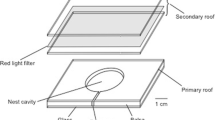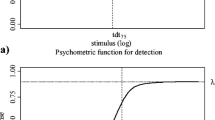Abstract
We study the plasticity of collective decision-making in ants by blocking key aspects of pheromone communication across entire colonies. To achieve this, droplets of paint were applied over the gaster tips of entire worker populations within colonies of the rock ant, Temnothorax albipennis. This treatment should prevent pheromone release potentially from each ant’s Dufour’s, poison, and pygidial glands in addition to the hindgut. We then examined the collective decision-making abilities of treatment and control colonies over alternative new nest sites in binary choice experiments. The performance of treatment colonies was compared with that of control colonies that had also been marked with paint but in such a way as not to disrupt their pheromone excretions from the gaster tip. Our results reveal the importance of “gaster-tip” pheromones during colony emigrations. Treatment-colony emigrations were significantly less successful than those of the controls, as the quality of their nest site assessments was reduced. However, treatment ants presented an extraordinary example of behavioral plasticity as they reduced their quorum thresholds in order to maintain normal emigration completion times. Hence, the ants whose communication systems have been compromised can still emigrate swiftly and maintain low levels of colony exposure.








Similar content being viewed by others
References
Basari N, Laird-Hopkins BC, Sendova-Franks AB, Franks NR (2014) Trail laying during tandem-running recruitment in the ant Temnothorax albipennis. Naturwissenschaften 101:549–556
Biebach H, Gordijn M, Krebs JR (1989) Time-and-place learning by garden warblers, Sylvia borin. Anim Behav 37:353–360
Cammaerts MC, Cammaerts D (2009) Light thresholds for colour vision in workers of the ant Myrmica sabuleti. Belg J Zool 139:40–49
Daan S, Koene P (1981) On the timing of foraging flights by oystercatchers, Haematopus ostralegus, on tidal mudflats. Neth J Sea Res 15:1–22
Doran C, Pearce T, Connor A, Schlegal T, Franklin E, Sendova Franks AB, Franks NR (2013) Economic investment by ant colonies in searches for better homes. Biol Lett 9:5
Dornhaus A, Franks NR (2006) Colony size affects collective decision-making in the ant Temnothorax albipennis. Insect Soc 53:420–427
Dornhaus A, Franks NR, Hawkins RM, Shere HNS (2004) Ants move to improve: colonies of Leptothorax albipennis emigrate whenever they find a superior nest site. Anim Behav 67:959–963
Franklin EL (2014) The journey of tandem running: the twists, turns and what we have learned. Insect Soc 61:1–8
Franks NR, Richardson T (2005) Teaching in tandem-running ants. Nature 439:153
Franks NR, Pratt SC, Mallon EB, Britton NF, Sumpter DJT (2002) Information flow, opinion polling, and collective intelligence in house hunting social insects. Philos Trans R Soc Lond 357:1567–1583
Franks NR, Mallon EB, Bray HE, Hamilton MJ, Mischler TC (2003) Strategies for choosing between alternatives with different attributes: exemplified by house hunting ants. Anim Behav 65:215–223
Franks NR, Dornhaus A, Best CS, Jones EL (2006) Decision-making by small and large house-hunting ant colonies: one size fits all. Anim Behav 72:611–616
Franks NR, Dechaume-Moncharmont F-X, Hanmore E, Reynolds JK (2009) Speed versus accuracy in decision-making ants: expediting politics and policy implementation. Philos Trans R Soc B 364:845–852
Franks NR, Richardson TO, Stroeymeyt N, Kirby RW, Amos WMD, Hogan PM, Marshall JAR, Schlegal T (2013) Speed-cohesion trade-offs in collective decision making in ants and the concept of precision in animal behaviour. Anim Behav 85:1233–1244
Gould JL (1976) The dance-language controversy. Q Rev Biol 51:211–244
Grueter C, Leadbeater E (2014) Insights from insects about adaptive social information use. Trends Ecol Evol 29:177–184
Hölldobler B, Wilson EO (1990) The ants. Harvard University Press, Harvard
Krieger M, Billeter JB, Keller L (2000) Ant-like task allocation and recruitment in cooperative robots. Nature 406:992–995
Mallon EB, Franks NR (2000) Ants estimate area using Buffon’s needle. Proc R Soc Lond B 267:165–770
Mallon EB, Pratt SC, Franks NR (2001) Individual and collective decision-making during nest site selection by the ant Leptothorax albipennis. Behav Ecol Sociobiol 50:352–359
Maschwitz U, Schönegge P (1977) Recruitment gland of Leptogenys chinensis. Naturwissenschaften 64:589–590
Maschwitz U, Schönegge P (1983) Forage communication, nest moving recruitment, and prey specialization in the oriental ponerine Leptogenys chinensis. Oecologia 57:175–182
McLeman MA, Pratt SC, Franks NR (2002) Navigation using visual landmarks by the ant Leptothorax albipennis. Insect Soc 49:203–208
Mitra A (2013) Function of the Dufour’s gland in solitary and social hymenoptera. J Hymenopt Res 35:33–58
Möglich M (1979) Tandem calling pheromone in the genus Leptothorax (Hymenoptera: Formicidae): behavioural analysis of specificity. J Chem Ecol 5:35–52
Möglich M, Hölldobler B (1974) Social carry behaviour and the division of labour during nest moving of ants. Psyche 81:219–236
Pratt SC (2005) Quorum sensing by encounter rates in the ant Temnothorax albipennis. Behav Ecol 16:488–496
Pratt SC, Brooks SE, Franks NR (2001) The use of edges in visual navigation by the ant Leptothorax albipennis. Ethology 107:1125–1136
Pratt SC, Mallon EB, Sumpter DJT, Franks NR (2002) Quorum sensing, recruitment, and collective decision-making during colony emigration in the ant Leptothorax albipennis. Behav Ecol Sociobiol 52:117–127
Richardson TO, Sleeman PA, McNamara JM, Houston AI, Franks NR (2007) Teaching with evaluation in ants. Curr Biol 17:1520–1526
Roberts WA (2002) Are animals stuck in time? Psychol Bull 128:479–489
Robinson EJ, Smith FD, Sullivan KM, Franks NR (2009) Do ants make direct comparisons? Proc R Soc B 276:2635–2641
Schürch R, Grüter C (2014) Dancing bees improve colony foraging success as long-term benefits outweigh short-term costs. PLoS ONE 9(8):e104660. doi:10.1371/journal.pone.0104660
Seeley TD (1983) Division of labour between scouts and recruits in honeybee foraging. Behav Ecol Sociobiol 12:253–259
Sendova-Franks AB, Franks NR (1993) Task allocation in ant colonies within variable environments (a study of temporal polyethism: experimental). Bull Math Biol 55:75–96
Sendova-Franks AB, Franks NR (1995) Division of labour in a crisis: task allocation during colony emigration in the ant Leptothorax unifiascus. Behav Ecol Soiobiol 36:269–282
Sherman G, Visscher K (2002) Honeybee colonies achieve fitness through dancing. Nature 419:920–922
Soroker V, Fresneau D, Hefetz A (1998) Formation of colony odor in ponerine ant Pachycondyla apicalis. J Chem Ecol 24:1077–1090
Von Frisch K (1967) The dance language and orientation of bees. Harvard University Press, Harvard
Wilkie DM, Carr JAR, Siegenthaler A, Lenger B, Liu M, Kwok M (1996) Field observations of time-place behaviour in scavenging birds. Behav Process 38:77–88
Wilson EO (1971) The insect societies. Cambridge, MA: Harvard University Press
Wilson EO, Hölldobler B (2005) The rise of the ants: a phylogenetic and ecological explanation. PNAS 102:7411–7414
Acknowledgments
We thank Ana Sendova-Franks, Carolina Doran, and Liz Langridge for comments on the manuscript. We thank all the members of the lab for assistance with experiments. Daphna Gottlieb was funded by a Marie Curie research grant 274342. We also wish to thank the anonymous reviewers of this paper for their very helpful comments.
Author information
Authors and Affiliations
Corresponding author
Additional information
Communicated by W. O. H. Hughes
Jonathan P. Stuttard and Daphna Gottlieb contributed equally to this work.
Rights and permissions
About this article
Cite this article
Stuttard, J.P., Gottlieb, D. & Franks, N.R. Ants incommunicado: collective decision-making over new nest sites by ants with reduced communication. Behav Ecol Sociobiol 70, 145–155 (2016). https://doi.org/10.1007/s00265-015-2033-7
Received:
Revised:
Accepted:
Published:
Issue Date:
DOI: https://doi.org/10.1007/s00265-015-2033-7




